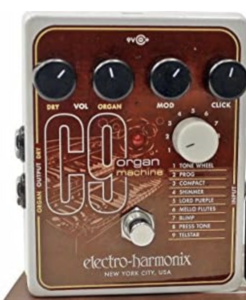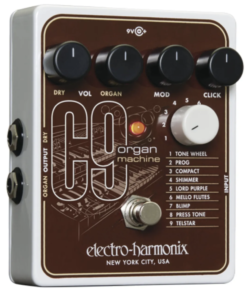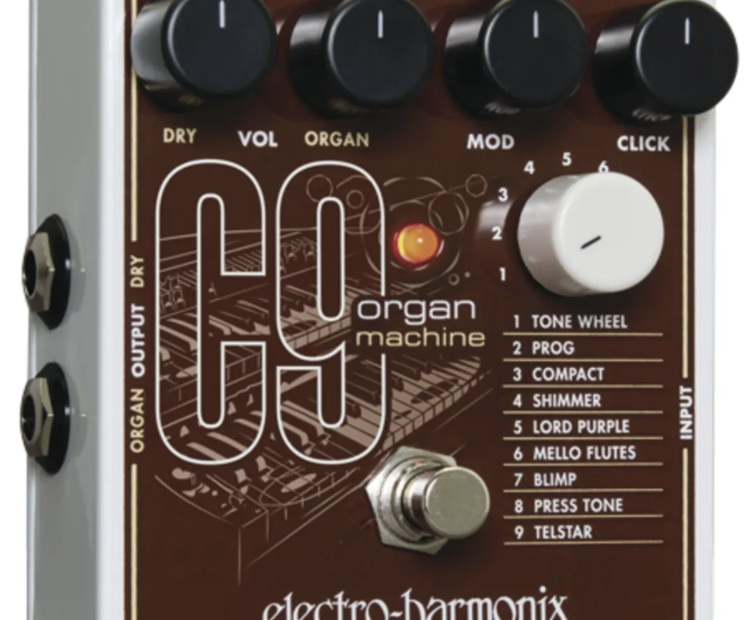The Electro-Harmonix C9 Organ Machine is a pedal designed to emulate the sounds of various vintage electric organs and other keyboard instruments using a guitar or other instrument as the input source.
It’s part of the EHX “9” series like the Key 9, which focuses on replicating the sounds of specific instruments or effects. The C9 is particularly aimed at recreating the tones of classic organs, including drawbar settings, percussive effects, and rotary speaker simulations. Similar pedals are the Mooer E7 and Source Audio C4. Here are some key features of the Electro-Harmonix C9 Organ Machine:
Organ Emulation
 The C9 pedal [buy here] offers a selection of nine different presets, each emulating the sound of a specific type of vintage electric organ or keyboard instrument. These sounds include classic tonewheel organs, transistor organs, and other keyboard tones.
The C9 pedal [buy here] offers a selection of nine different presets, each emulating the sound of a specific type of vintage electric organ or keyboard instrument. These sounds include classic tonewheel organs, transistor organs, and other keyboard tones.
The Electro-Harmonix C9 Organ Machine [buy here] is designed to capture the distinct tonal characteristics of classic electric organs and keyboard instruments. It achieves this by providing a selection of nine different presets, each meticulously crafted to replicate the sound of a specific type of organ or keyboard. These presets cover a range of iconic organ tones, including tonewheel organs, transistor organs, and more.
The C9 allows you to recreate the classic sounds of vintage electric organs that played a significant role in shaping the sound of various musical genres. This includes the warm and rich tones of tonewheel organs like the Hammond B3, as well as the percussive and punchy character of transistor organs.
Also Read:
Electro-Harmonix Key 9 Pedal Review: Electric Piano Machine
Mooer E7: Polyphonic Guitar Synth Effects Pedal Review
Guitar Synthesizer: BOSS SY-1 Pedal
PRS SE Custom 24 Guitar Review
Jackson Custom Shop Exclusive SL2H-V Soloist guitar
Keyboard Instruments
 In addition to organ sounds, some presets on the C9 also capture the essence of other vintage keyboard instruments. These may include electric pianos, clavinets, and other tonal variations that were popular in different musical contexts.
In addition to organ sounds, some presets on the C9 also capture the essence of other vintage keyboard instruments. These may include electric pianos, clavinets, and other tonal variations that were popular in different musical contexts.
Polyphonic Tracking
One of the standout features of the C9 is its polyphonic tracking capability. This means that the pedal can accurately track and reproduce multiple notes played simultaneously, including chords and complex harmonies.
This polyphonic tracking ensures that your playing remains articulate and expressive even when using a full range of notes.
Like other pedals in the “9” series, the C9 is polyphonic, meaning it can accurately track and reproduce chords and complex playing styles. This allows you to play full chords and harmonically rich phrases.
Dedicated Controls
To fine-tune and shape the emulated organ sounds, the C9 provides dedicated controls that allow you to adjust various parameters. These controls typically include:
- Blend: This control lets you mix the dry guitar signal with the processed organ sound. You can dial in the perfect balance between your original guitar tone and the organ effect.
- Mod: Adjusts the depth of modulation, allowing you to control the intensity of effects like vibrato and chorus.
- Click: Controls the key click percussion, adding authenticity to the organ sound.
- Organ Type: A rotary selector that allows you to choose from the nine different presets, each representing a unique organ or keyboard instrument.
Expression Pedal Input
 The expression pedal input on the C9 adds an extra layer of expressiveness to your playing. By connecting an expression pedal, you can control various parameters in real-time, such as volume swells, modulation depth, or other effects, giving you hands-free control over the sound.
The expression pedal input on the C9 adds an extra layer of expressiveness to your playing. By connecting an expression pedal, you can control various parameters in real-time, such as volume swells, modulation depth, or other effects, giving you hands-free control over the sound.
The expression pedal input is a versatile feature found in many effects pedals, including the Electro-Harmonix C9 Organ Machine. It allows you to connect an external expression pedal to the pedal, enabling you to control various parameters in real-time using your foot. This adds an extra layer of interactivity and expressiveness to your playing and allows you to manipulate effects and sound parameters dynamically. Here’s a closer look at the expression pedal input and its significance:
How Expression Pedal Input Works: An expression pedal is a foot-controlled pedal that generates a variable voltage signal based on its position. When connected to an effects pedal with an expression pedal input, the expression pedal’s signal is used to control specific parameters within the pedal. As you move the expression pedal, the signal changes, and the controlled parameter responds accordingly.
Significance of Expression Pedal Input: The expression pedal input offers several important advantages and creative possibilities:
- Real-Time Control: Expression control allows you to adjust parameters in real-time while you’re playing. This is particularly valuable for adding dynamic changes and modulation effects to your sound without needing to stop and make manual adjustments on the pedal.
- Expressive Playing: With an expression pedal, you can create gradual fades, swells, and transitions in volume, modulation depth, or other effects. This adds a level of expressiveness to your playing that is challenging to achieve using traditional controls alone.
- Dynamic Effects: Expression control enables you to perform effects like wah-wah, tremolo, vibrato, and more with your foot, freeing up your hands to focus on playing your instrument.
- Hands-Free Operation: By using your foot to control parameters, you can keep your hands on your instrument, making it easier to create complex soundscapes, adjust effects on the fly, and explore different tonal variations during a performance.
- Sound Shaping: The expression pedal input can be assigned to control a variety of parameters, such as volume, modulation rate, depth, filter cutoff, and more. This gives you the ability to shape your sound exactly as you envision it.
Using Expression Control with the C9 Organ Machine
On the Electro-Harmonix C9 Organ Machine, the expression pedal input allows you to add a new layer of control to your organ and keyboard sounds. Depending on the specific parameters available on the C9, you might use expression control to:
- Adjust Volume Swells: Create smooth volume swells that add a dynamic and atmospheric quality to your organ tones.
- Modulate Depth: Control the depth of modulation effects like vibrato or chorus, adding texture and movement to the sound.
- Key Click Percussion: Use the expression pedal to dial in the intensity of the key click percussion effect, enhancing the authenticity of the organ emulation.
- Blend Between Dry and Wet Signals: Adjust the balance between your original guitar signal and the processed organ sound, allowing for seamless transitions between different tonal characteristics.
The expression pedal input empowers you to perform and shape your sound in a dynamic and intuitive way. By integrating an expression pedal into your setup, you can unlock a world of creative possibilities and elevate your playing to new heights.
Other Features
- Stereo Output: The stereo output capabilities of the C9 allow you to take full advantage of the spatial effects and depth of the organ sounds. When connected to stereo equipment, the pedal can create an immersive and wide sonic experience.
- Effect Blend: The Blend control lets you mix the dry guitar signal with the processed organ sound, allowing you to find the perfect balance between your original tone and the effect.
- True Bypass: The C9 pedal features true bypass switching, ensuring that your guitar’s original signal remains unaltered when the pedal is disengaged.
- Sturdy Build: Electro-Harmonix pedals are known for their durable construction. The C9 is built to withstand the rigors of live performances and studio use.
- Power Options: The pedal can be powered using a standard 9-volt DC power supply.
The Electro-Harmonix C9 Organ Machine [buy here] is a versatile pedal that allows guitarists and other musicians to add authentic organ tones to their performances and recordings.
